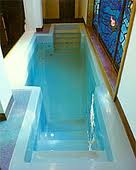Scummy Baptistry in Texas Church Cleaned Up by Electronic Softener Alternative
After years of enduring the embarrassment of leading converts into a baptismal pool stained with unsightly spots and hardness scaling, pastor Elroy
Townsend of the Church of Christ of Spinner, Texas convinced the budget committee to provide funds for an electronic scale-prevention system for the church’s baptistry. The result has been spectacular.
Within a few days of installation of the new system, Townsend said, ugly hard water residue began to disappear. “It was like a miracle,” the pastor exclaimed.
Spinner’s water supply, which comes from a deep well, is extremely hard. “Almost hard enough to walk on,” Townsend said, then he quickly added, “Just joking.”
Other area churches have tried a variety of solutions to the hard water dilemma. The First Baptist, with the town’s largest congregation, has for years used a conventional water softener provided free by a local water treatment dealer whose colorful logo can be seen at back of the baptismal pool. A small Methodist congregation in Spinner even filled its baptistry with bottled reverse osmosis water for a time, but has since abandoned the practice because of the expense.
“I looked at both these options before deciding on the electronic descaler,” Townsend said, “but people really don’t like the slick feel of conventionally softened water, and the bottled reverse osmosis water has the natural minerals removed. We feel that baptism just isn’t the same unless the water used has its full complement a natural minerals, as the Lord intended.”
More about scale prevention in baptistries.





![img031[1]](http://purewatergazette.net/blog/wp-content/uploads/2012/10/img0311.jpg)
 ) of marine fishes and invertebrates is fundamentally limited by the balance between energy demand and supply, where
) of marine fishes and invertebrates is fundamentally limited by the balance between energy demand and supply, where  is reached when energy demand = energy supply (thus net growth = 0).
is reached when energy demand = energy supply (thus net growth = 0).![nclimate1691-f2[1]](http://purewatergazette.net/blog/wp-content/uploads/2012/10/nclimate1691-f21.jpg)
![Ops-Challenge-4-Large-300x259[1]](http://purewatergazette.net/blog/wp-content/uploads/2012/10/Ops-Challenge-4-Large-300x2591.jpg)


